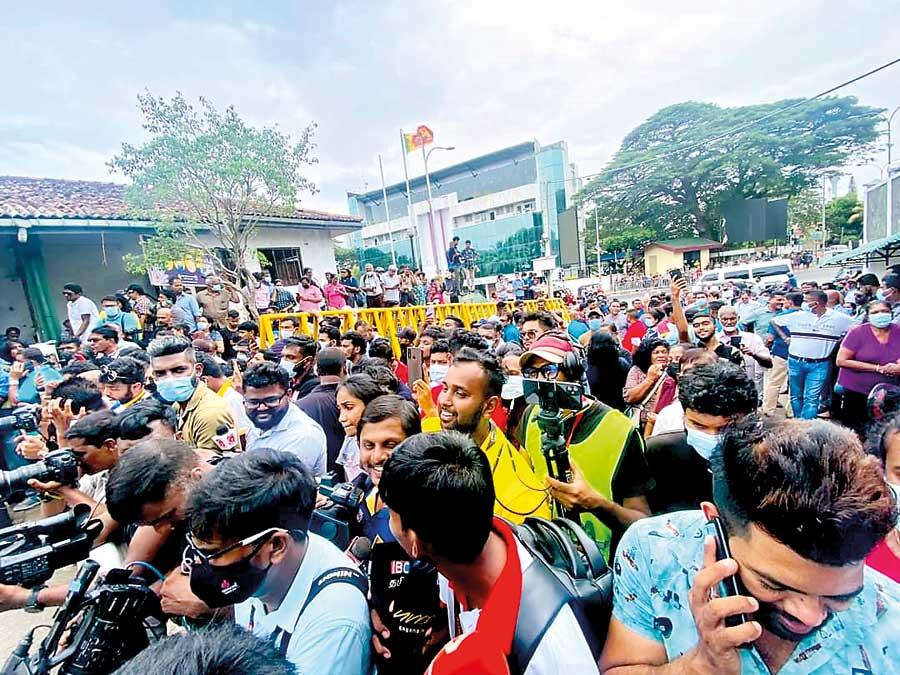Reply To:
Name - Reply Comment
Last Updated : 2024-05-18 20:50:00

The tasks of journalists, reporters and photographers were increasingly challenging when their presence at the protest sites which most of the times turned intense and posing threats to life
On April 1 this year I awoke to over 500 messages that had accumulated on my phone overnight. For weeks, my home country of Sri Lanka had been engulfed in public protests as skyrocketing prices forced more and more people on to the streets.
home country of Sri Lanka had been engulfed in public protests as skyrocketing prices forced more and more people on to the streets.
Overnight, protesters had gathered near the private residence of then President Gotabaya Rajapaksa, a popular agitation location. This time however, as the protestors marched towards the house they were met with teargas and water cannons. At least three vehicles used by the security forces were set on fire. Over 50 people, including journalists, were injured.
While I had been watching what was happening in Sri Lanka regularly, April 1 was the day that signalled my life would come to be dominated by the Aragalaya, the name that was attributed to the protest wave taking place thousands of miles away.
I was in touch with friends, colleagues, and mentees who I had worked closely with in the past. I knew personally how difficult it was to report in Sri Lanka even under the best of circumstances. Between 1992 and 2022, 25 of my colleagues have been killed, over a dozen of them murdered including my former editor Lasantha Wickrematunge. Not a single investigation into these heinous crimes have so far resulted in a conviction.
Reporting on wave after wave of public protests over six months, under such historically repressive conditions, felt like being on a never-ending treadmill. My colleagues told me that they were gasping for breath at the end of every day.
"Reporting on wave after wave of public protests over six months, under such historically repressive conditions, felt like being on a never-ending treadmill. My colleagues told me that they were gasping for breath at the end of every day"
“I feel like I am facing two different fronts at the same time,” Eranga Jayawardena, a photojournalist with over two decades of experience said. Each day as he went out to document the protests growing larger, he also had to keep an eye on how his family was coping with rising costs, shortages in essential items and medicine, power cuts and fuel lines that snaked for miles.
“It has been a struggle to just make sure that we have some control,” Jayawardena said.
Other colleagues feel that they have little or no opportunity to discuss and deal with the mounting pressures faced by journalists, as everyone else is also facing multiple crises. Sarah Hannan, a reporter with a national weekly reflects on how she does not want to burden her loved ones with the pressures she faces when, as she pointed out, the entire community is on survival mode.
Recently when she heard a news that a friend had been arrested while taking part in protests, she felt not only helpless but voiceless.
“My friend was arrested yesterday, it’s distressing because everybody is asking me what is happening? Whether somebody can go and help? I even contacted some of the lawyers. They also can’t get through (to the detained protesters) yet,” she said.
After years of reporting on war, humanitarian crises, and political upheavals, Jayawardena began to question the value he placed on himself as a visual documentarian. “I just feel that the journalism has had no impact,” he said.
This sense of helplessness has influenced some journalists to clearly identify with the protest movement, both Jayawardena and Hannan feel. This has been especially manifest on social media.
"Between 1992 and 2022, 25 of my colleagues have been killed, over a dozen of them murdered including my former editor Lasantha Wickrematunge. Not a single investigation into these heinous crimes have so far resulted in a conviction"
“The difference between reporting the war and reporting the Aragalaya, has been that with the war, there was always the chance to break away from the story, even for a short time, with the protests it has been relentless, everywhere, all the time. There was absolutely no chance of a break,” Buddhika Weerasinghe, a veteran photographer said.
Weerasinghe, a Dart Centre Asia Pacific Fellow, returned to Sri Lanka for a four-month period earlier this year to document the protests. He now lives in Japan after fleeing in 2009 due to threats during his reporting of the last stages of the civil conflict.
Weerasinghe also noticed that the lack of skills and need for more peer support made journalists feel extra vulnerable, more so when they came under threat or attack while covering the protests. The protests and social upheaval around them has also made the Sri Lankan journalism community confront mental safety issues that have remained long neglected.
Piyumi Fonseka, the deputy investigations editor at the Daily Mirror recalled a time when any mention of mental fragilities would invite ridicule, even in newsrooms. “Whenever we talk about mental health issues, we often get branded or the topic gets disregarded as unimportant, now more people are talking that this is really an alarming situation. This is an issue. It’s not limited to one person,” said Fonseka.
Fonseka, Jayawardena, and Hannan were part of a group of 12 journalists from Sri Lanka who took part in a three-day programme on psychosocial safety conducted by the Dart Centre for Journalism and Trauma, Asia Pacific. The programme, the first of its kind focused on supporting journalists in crisis, has set up the foundation for an ongoing peer-support network for journalists.
Such support is vital, especially considering the participants were candid in their reflections that Sri Lankan journalism has long adapted a bulletproof façade in the face of violent repression.
“It is something that is almost organic working as a journalist in Sri Lanka, it will take time to change,” Weerasinghe said. Originally published by the Dart Centre for Journalism and Trauma, Asia Pacific
The writer is a journalism researcher and the Project Lead at the Dart Centre Asia Pacific.
He can be contacted on
amantha.perera@cqumail.com

Add comment
Comments will be edited (grammar, spelling and slang) and authorized at the discretion of Daily Mirror online. The website also has the right not to publish selected comments.
Reply To:
Name - Reply Comment
The state-run loss-making State Mortgage & Investment Bank (SMIB) has reveale
US authorities are currently reviewing the manifest of every cargo aboard MV
On March 26, a couple arriving from Thailand was arrested with 88 live animal
According to villagers from Naula-Moragolla out of 105 families 80 can afford
17 May 2024 - 0 - 114